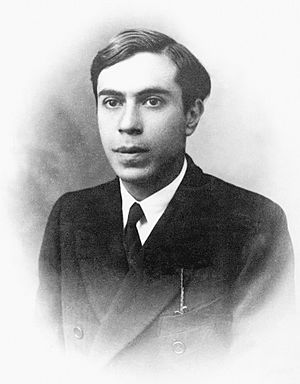Majorana fermion facts for kids
A Majorana fermion is a special kind of tiny particle. It's unique because it's exactly the same as its own antiparticle. Imagine looking in a mirror and seeing your exact twin – that's kind of how a Majorana fermion works!
An Italian physicist named Ettore Majorana first thought about these particles in 1937. He disappeared in 1938, and these particles are named after him.
Since a Majorana fermion is its own antiparticle, it cannot have an electric charge. Particles that do have an electric charge, like electrons (which are negative) and positrons (which are positive), are called Dirac fermions. Electrons and positrons are like twins, but with opposite charges.
Some scientists wonder if neutrinos might be Majorana fermions. Neutrinos are tiny particles with no electric charge. Their exact nature is still a mystery.
Contents
What the Theory Says
The idea of Majorana fermions came from Ettore Majorana in 1937. He suggested that certain neutral particles, which have a property called spin (like a tiny top spinning), could be described in a special way. This special description would mean they are identical to their own antiparticles.
In simple terms, for a Majorana fermion, the particle and its antiparticle are the same thing. This is different from other particles, where the particle and antiparticle are distinct.
Majorana Fermions in Physics
The Standard Model
The Standard Model of particle physics is our best theory for how particles and forces work. In this model, all known particles are Dirac fermions. This means they are different from their antiparticles.
For example, the Standard Model includes neutrinos and antineutrinos. In the Standard Model, neutrinos are thought to have no mass. Scientists are still trying to figure out if neutrinos are truly different from antineutrinos. If they are the same, then neutrinos would be Majorana fermions.
Beyond the Standard Model
Scientists are always looking for ways to improve the Standard Model. Some new theories, like the Minimal Supersymmetric Standard Model, suggest that Majorana fermions could exist.
In these theories, a type of particle called a neutralino might be a Majorana fermion. Neutralinos are "superpartners" of other particles.
Majorana fermions can also appear in a different area of physics called condensed matter physics. Here, they are not single particles. Instead, they appear as "quasiparticles." A quasiparticle is like a collective movement or behavior of many particles acting together. These quasiparticles could behave in very strange and useful ways.
See also
 In Spanish: Fermión de Majorana para niños
In Spanish: Fermión de Majorana para niños


